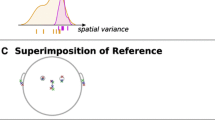Summary
An initial investigation of controversies and differences in opinion in the various schools of functional anatomy is presented by listing the methodology problems.
The possibilities and limitations of functional anatomy are derived from the successive steps in the procedure in a functional anatomical investigation.
Starting from the holistic approach as introduced byVan der Klaauw, the main problems of defining the term functional component and the applied methods are discussed.
Two principal methods are presented, of which the limitations are considered. The various aspects where new information is needed are illustrated in the example of bone mechanics. The advantages of an approach from a pattern of the interrelations are mentioned.
Similar content being viewed by others
References
Bertalanffy, L. von (1952), Problems of life. An evalution of modern biological and scientific thought.- New York, Harper, 1960, 216 p.
Bonfield, W. (1966), Deformation and fracture of bone. - J. App. Physiol. 37 (2), 869–875.
Driesch, H. (1928), Philosophie des Organischen. Quelle & Meyer, Leipzig, 402 p.
Dullemeijer, P. (1956), The functional morphology of the head of the common viper, Vipera berus (L.).- Arch. Néerl. de Zoologie, II, 386–497.
— (1959), A comparative functional-anatomical study of the heads of some Viperidae.- Morph. Jb., 99, 882–985.
Evans, F. G. (1968), Bibliography on the physical properties of the skeletal system. University of Michigan, Ann Arbor, 42 p.
Huson, A. (1961), Een ontleedkundig-functioneel onderzoek van de voetwortel. Thesis, Leiden.
Klaauw, C. J. van der (1945), Cerebral skull and facial skull. - Arch. Néerl. Zool. VII, 16–37.
— (1948–1951), Size and position of the functional components of the skull. - Arch. Néerl. Zool. IX, 1–559.
— (1964), Elements for an objective and neutral introduction to the philosophic backgrounds and prospects of the biological sciences.- Proc. Kon. Ned. Akad. Wet. Inst., C., 67, 119–127.
Kummer, B. (1959), Bauprinzipien des Säugerskeletes.- G. Thieme, Stuttgart, 235 P.
— (1962), Funktionelle Bau und funktionelle Anpassung des Knochens. - Anat. Anz. 111, 261–293.
Meyer-Abich, A. (1940), Hauptgedanken des Holismus.- Acta Bioth. V, 85–116.
Moss, M. L. (1960), Functional analysis of human mandibular growth.- J. Prosth. Dentistry, 10, 1149–1159.
Pauwels, F. (1954), Über die Verteilung der Spongiosa dichte im coxalen Femurende und ihre Bedeutung für die Lehre vom funktionellen Bau des Knochens. - Morph. Jb., 95, 35–54.
Rashevsky, J. (1960), Mathematical biophysics. Vol. I.- New York, Dover, 488 p.
Rudwick, M. J. S. (1964), The inference of function from structure in fossils. - Brit. J. Phil. Sc. 15, 27–41.
Schwab, J. J. (1960), What do scientists do?- Behavioral Science, 3, 1, 1–27.
Simpson, G. G. (1949), The meaning of evolution.- New Haven, Yale Univ. Press.
Author information
Authors and Affiliations
Rights and permissions
About this article
Cite this article
Dullemeijer, P. Some methodology problems in a holistic approach to functional morphology. Acta Biotheor 18, 203–214 (1968). https://doi.org/10.1007/BF01556728
Issue Date:
DOI: https://doi.org/10.1007/BF01556728




